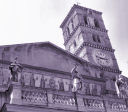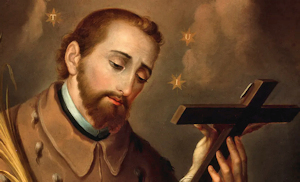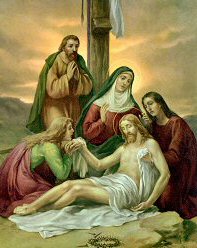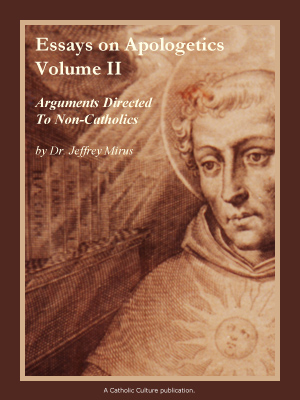Lent: March 20th
Thursday of the Second Week of Lent
Other Commemorations: St. John Nepomucene, Priest and Martyr (RM)
» Enjoy our Liturgical Seasons series of e-books!
Today's Station Church is St. Mary in Trastevere, rebuilt in the twelfth century. After St. Mary Major, it is considered the most beautiful church dedicated to Our Lady in Rome.
The thought expressed in today’s first reading in Jeremias is one of the basic themes of the great prophets; it is to be found also in the Psalms (particularly Ps 1) and the book of Proverbs. Trust in men and trust in God—the former belies our expectations and only the latter assures our happiness and enables us to “bring forth good fruit.”
The parable of the rich man and Lazarus, the beggar, is addressed to the Pharisees. The rich man stands for the haughty man who, proudly satisfied with the gifts that God has bestowed on him, is unaware that living as he does he loses God’s favour. The teaching is the same as in the Epistle; blessed are the poor in spirit: those who put their trust in God. —St. Andrew Daily Missal
The Roman Martyrology commemorates St. John Nepomucene (1340-1393), priest of Bohemia, martyred by King Wenceslaus IV because St. John refused to break the seal of confession. He was tortured and thrown into the Moldau River. It is said that a strange brightness is said to have appeared above the spot where he drowned, so his body was found and withdrawn from the water and interred.
Meditation for Thursday of the Second Week of Lent—Prayer of Confidence in the Merits and Merciful Power of Jesus
The proud who claim to draw their power form themselves, commit the sin of Lucifer, who said: “I will ascend into Heaven…. I will be like the Most High”; like Lucifer they will be overthrown and cast down into the abyss.
But what do we say? That without Christ, we can do nothing, as He has Himself declared. We declare that it is through Jesus, with Jesus, that we can arrive at holiness and enter into Heaven; we say to Christ: “Master, I am poor, miserable, naked, weak, of this I am daily more and more convinced. But I know, too, that Thou art ineffably powerful, great and good; I know that the Father Thou lovest so much hath placed in Thee all the treasures of holiness that men may desire; I know that Thou wilt never reject those who come to Thee. Therefore, whilst adoring Thee in the deepest recesses of my soul, I have full confidence in Thy merits and satisfactions; I know that, altogether miserable as I am, Thou canst, by Thy grace, shower Thy riches upon me, uplift me even to the Divine, that I may be made like unto Thee and may share in Thy Divine Beatitude!”
—Dom Columba Marmion, Christ the Ideal of the Monk
Meditation for Thursday of the Second Week of Lent—Prayer of Confidence in the Merits and Merciful Power of Jesus
The proud who claim to draw their power form themselves, commit the sin of Lucifer, who said: “I will ascend into Heaven…. I will be like the Most High”; like Lucifer they will be overthrown and cast down into the abyss.
But what do we say? That without Christ, we can do nothing, as He has Himself declared. We declare that it is through Jesus, with Jesus, that we can arrive at holiness and enter into Heaven; we say to Christ: “Master, I am poor, miserable, naked, weak, of this I am daily more and more convinced. But I know, too, that Thou art ineffably powerful, great and good; I know that the Father Thou lovest so much hath placed in Thee all the treasures of holiness that men may desire; I know that Thou wilt never reject those who come to Thee. Therefore, whilst adoring Thee in the deepest recesses of my soul, I have full confidence in Thy merits and satisfactions; I know that, altogether miserable as I am, Thou canst, by Thy grace, shower Thy riches upon me, uplift me even to the Divine, that I may be made like unto Thee and may share in Thy Divine Beatitude!”
—Dom Columba Marmion, Christ the Ideal of the Monk

Thursday of the Second Week of Lent
Station with Santa Maria in Trastevere (St. Mary in Trastevere ):
The Station for today is in the celebrated basilica, St. Maria in Trastevere. The basilica was consecrated in the third century, under the pontificate of St. Callixtus, and was the first church built in Rome in honor of our Blessed Lady, particularly for her Assumption. The original church was demolished and the current church was constructed between 1139 to 1181, with additions such as mosaics and chapels added through the centuries.
For more on Santa Maria in Trastevere, see:
- Churches of Rome
- The Station Churches of Rome
- Rome Art Lover
- Roman Churches
- PNAC
- Aleteia
- Station Church
- The Catholic Traveler
For further information on the Station Churches, see The Stational Church.
St. John Nepomucene (Nepomuk)
 Born at Nepomuk, Bohemia, 1340; died in Prague, March 20, 1393; canonized in 1729. Saint John used the name of his native town for his surname instead of his family name of Woelflein or Welflin. He studied at the University of Prague, was ordained, and became a canon. In time, he became vicar general of Archbishop John of Genzenstein at Prague and according to tradition incurred the enmity of dissolute King Wenceslaus IV when he refused to reveal what Queen Sophie, Wenceslaus’ second wife, had told him in confession. Of a retiring disposition, Father John repeatedly refused bishoprics which were offered to him.
Born at Nepomuk, Bohemia, 1340; died in Prague, March 20, 1393; canonized in 1729. Saint John used the name of his native town for his surname instead of his family name of Woelflein or Welflin. He studied at the University of Prague, was ordained, and became a canon. In time, he became vicar general of Archbishop John of Genzenstein at Prague and according to tradition incurred the enmity of dissolute King Wenceslaus IV when he refused to reveal what Queen Sophie, Wenceslaus’ second wife, had told him in confession. Of a retiring disposition, Father John repeatedly refused bishoprics which were offered to him.
In 1393 (or 1383 according to some), he became involved in a dispute between Wenceslaus and the archbishop when the king sought to convert a Benedictine abbey into a cathedral for a new diocese he proposed to create for a favorite when the aged abbot died. The archbishop and John thwarted him by approving the election of a new abbot immediately on the death of the old abbot. At a meeting with John and other clerics, Wenceslaus flew into a rage, tortured them so that John was seriously injured, and then had him murdered and thrown into the Moldau River at Prague (Attwater, Benedictines, Delaney).
Saint John is portrayed in art as an Augustinian canon with a fur almuce and a bridge near him. He may hold his finger to his lips and have seven stars around his head, or wear a padlock on his lips (in Austria and Bohemia). John, patron of confessors and bridges, is venerated in Austria and Spain (Roeder).
—by Katherine Rabenstein, Saints of the Day
Patronage: against calumnies; against floods; against indiscretions; against slander; bridge builders; bridges; canons; confessors; for discretion; for good confession; mariners, sailors, boatmen, watermen; running water; silence; spiritual directors; Bohemia; Czech Republic; archdiocese of Prague, Czech Republic; Slovakia; Venice, Italy
Symbols and Representation: halo with five stars; cross; bridge; angel indicating silence by a finger over the lips; priest's biretta
Highlights and Things to Do:
- Read more about St. John Nepomucene:
- Read about the location of Saint John of Nepomuk's Martyrdom.
- The Statue of St. John of Nepomuk on Charles Bridge in Prague.
- See Christian Iconnography for depictions of St. John.
- Learn more about Prague and the Czech Republic and St. Vitus Cathedral, supposedly started by St. Wenceslas in the 10th century as a small chapel to house relics of St. Vitus and were in the 14th century St. John Nepomucene was buried after being executed for refusing to violate the seal of the confessional.
- Read about the Infant Jesus of Prague and pray the chaplet.
- Bake a loaf of bread for dinner and serve Pilsner beer in honor of St. Wenceslas. See also Catholic Cuisine for other ideas.






